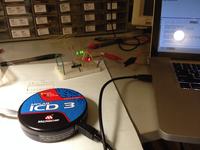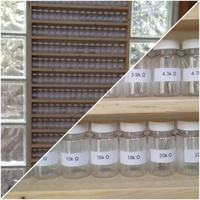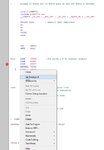maark6000
Member level 5

- Joined
- Jan 15, 2013
- Messages
- 92
- Helped
- 1
- Reputation
- 2
- Reaction score
- 1
- Trophy points
- 1,288
- Activity points
- 2,270
So, I thought I understood this downloading of one's program onto a chip. You plug your programmer (ICD3 in my case) into your USB port on your computer, you connect your target board via the mildly trustworthy RJ-11 cable, insert your chip into the board, and download your program. Since two of the connections from the programmer are Vdd and Vss, the PROGRAMMER will power your chip while downloading / debugging.
But then, that didn't work. MPLAB X kept giving me a "target not found" error, and a little clue was dropped with a dialogue window that opens up and begs "are you sure you're not using a 3.5V chip in there?"
Doing some searching of the internet for the "target not found" error, I found someone respond "the programmer doesn't think the chip has power." Wait a minute. If it's in the programmer... it has power... why else would there be Vdd and Vss pins? But then I thought well, what could it hurt if I try to jam 5 volts into the chip WHILE it's in the programmer... I mean these things are made to work in situ, right? So I did and voila... the program downloaded.
So, my question is... a: did I do that right? and b: am I completely crazy to mistakenly think that the programmer would power the chip while it was in there? and c: I have been reading a book and plenty of microchip documents on programming PIC microcontrollers... why have I never once read "Oh by the way, the chip must be independently powered from some other source than your programmer when you are trying to program it."?
Frustrating.
But then, that didn't work. MPLAB X kept giving me a "target not found" error, and a little clue was dropped with a dialogue window that opens up and begs "are you sure you're not using a 3.5V chip in there?"
Doing some searching of the internet for the "target not found" error, I found someone respond "the programmer doesn't think the chip has power." Wait a minute. If it's in the programmer... it has power... why else would there be Vdd and Vss pins? But then I thought well, what could it hurt if I try to jam 5 volts into the chip WHILE it's in the programmer... I mean these things are made to work in situ, right? So I did and voila... the program downloaded.
So, my question is... a: did I do that right? and b: am I completely crazy to mistakenly think that the programmer would power the chip while it was in there? and c: I have been reading a book and plenty of microchip documents on programming PIC microcontrollers... why have I never once read "Oh by the way, the chip must be independently powered from some other source than your programmer when you are trying to program it."?
Frustrating.







